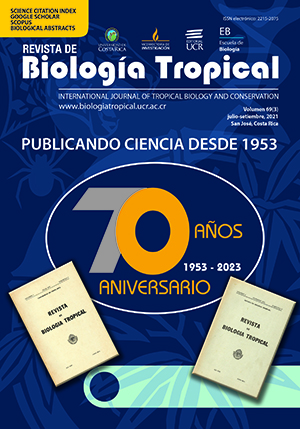Resumen
Introduction: The rose spotted snapper (Lutjanus guttatus) is a highly consumed marine fish and of commercial interest in Costa Rica, under a strong fishing pressure that can affect the genetic diversity of the population creating problems related to inbreeding depression. Objective: To evaluate the genetic diversity of the spotted snapper (Lutjanus guttatus) population in Costa Rica using microsatellites. Methodology: Samples were collected from two locations (Golfo Dulce and Golfo de Nicoya) in 2019, and 44 individuals from each site were studied. DNA extraction and amplification of 10 microsatellites by PCR were carried out for subsequent genotyping for genetic diversity and population structure analysis. Results: The genetic diversity parameters show a high polymorphism, associated to a high number of alleles per locus, but low levels of observed heterozygosity in comparison to the expected heterozygosity (Ho = 0,774 and 0,800 and He = 0,948 and 0,954 for Gulf of Nicoya and Gulf Dulce, respectively). The study of population differentiation indicates that there is not enough evidence to ensure the two populations are different (FST = 0,00264, p > 0.05). The significant deviation from Hardy-Weinberg Equilibrium obtained indicated the possible presence of organisms in the population that does not come from the wild. Conclusions: The rose spotted snapper in Costa Rica shows high levels of genetic diversity, without evidence of differentiation in genetic subpopulations, that should be considered as a single panmictic population for fishery management purposes. The possible mix of individuals of a distinct origin found in the wild suggests the presence of organisms that come from a stock enhancement program or from commercial aquaculture carried out in the region. The use of genetic markers is recommended to keep track of the genetic characteristics of the wild population, to follow-up stock enhancement programs, and eventually, asses their effect.
##plugins.facebook.comentarios##

Esta obra está bajo una licencia internacional Creative Commons Atribución 4.0.
Derechos de autor 2023 Revista de Biología Tropical


